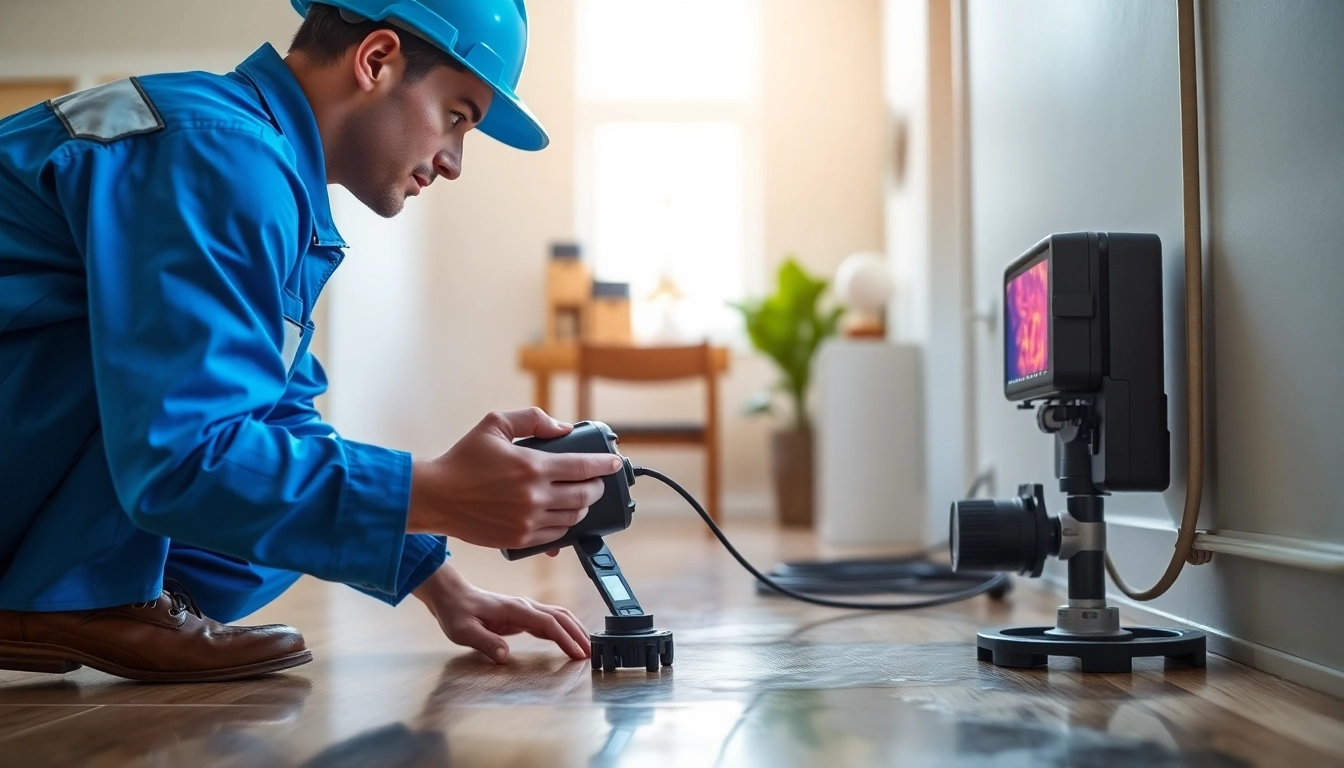Ultimate Guide to Underfloor Leak Detection: Prevent Costly Damage

Understanding the Importance of Underfloor Leak Detection
Underfloor leak detection is a critical service for homeowners and businesses alike, as it can prevent extensive damage caused by unnoticed leaks. Water can cause structural issues, promote mold growth, and lead to significant repair costs. Detecting these leaks early is vital, not only for safeguarding property but also for maintaining the integrity of plumbing systems. Various techniques and technologies are employed to achieve effective detection, and understanding these methods can help in promptly addressing potential issues. For thorough guidance on effective services, explore Underfloor Leak Detection.
Common Signs of Underfloor Leaks
Recognizing the signs of underfloor leaks is essential for timely intervention. Common indicators include:
- Wet Spots: Patches of damp flooring or moist carpets often indicate a leak beneath.
- Increased Water Bills: A sudden spike in water bills without a corresponding increase in usage can signal leaks.
- Unpleasant Odors: A musty smell may suggest mold or mildew growth due to prolonged moisture exposure.
- Warm or Cold Spots: Temperature variations on the floor surface might indicate heating or cooling fluid leaks from underfloor systems.
- Sound of Running Water: Hearing water running when no fixtures are in use can be a strong sign of a leak.
The Risks of Ignoring Underfloor Leaks
Ignoring underfloor leaks can lead to significant consequences, including:
- Structural Damage: Prolonged exposure to water can cause damage to flooring, subfloors, and even foundational elements.
- Mold Growth: Moist environments foster mold growth, which can pose health risks and require expensive remediation.
- Increased Costs: The longer a leak goes undetected, the higher the repair costs can become, encompassing everything from plumbing repairs to floor replacement.
- Decreased Property Value: Properties with hidden water damage or mold issues can face lower market values and difficulty in selling.
How Underfloor Leak Detection Works
Underfloor leak detection employs a variety of methods to pinpoint leaks effectively. Common techniques include:
- Visual Inspections: Trained professionals assess visible signs of leaking, enabling them to identify problematic areas.
- Thermal Imaging: Infrared cameras help visualize temperature differences, revealing areas where moisture may be present.
- Acoustic Listening Devices: These devices detect sound waves that water leaks produce, effectively locating the leak’s source.
- Moisture Meters: Professionals use these meters to measure moisture levels in flooring and materials, aiding in leak identification.
- Pressure Testing: This technique assesses the integrity of plumbing systems, helping to isolate leaks based on pressure drops.
Essential Tools for Effective Underfloor Leak Detection
Overview of Leading Technologies
Understanding the technologies behind underfloor leak detection can assist in appreciating their effectiveness and application. Leading technologies include:
- Infrared Cameras: These cameras detect heat patterns and temperature variances, showcasing hidden leaks.
- Acoustic Sensors: Sophisticated listening devices that capture noise frequencies indicative of water leaks.
- Thermal Imaging Sensors: Useful for both leak detection and identifying heating discrepancies in hydronic systems.
- Ground Penetrating Radar (GPR): A non-destructive method of imaging subsurface structures and detecting leaks in buried pipes.
Comparing Manual vs. Automated Leak Detection Methods
Leak detection can be conducted manually or via automated systems. Manual methods, while often involving skilled technicians, may take longer and depend on human accuracy. Automated systems leverage technologies like smart sensors that continuously monitor for signs of leaks and alert homeowners or maintenance personnel instantly. The decision between these methods often involves considerations regarding budget, urgency, and the complexity of the plumbing systems in question.
Choosing the Right Equipment for Your Needs
Choosing the appropriate leak detection equipment involves assessing specific needs and characteristics of the building. Factors to consider include:
- Building Size: Larger buildings may require more advanced equipment or a combination of tools for thorough detection.
- Type of Flooring: Certain materials may necessitate specific detection methods, such as sensitive acoustic sensors for hardwood floors.
- Accessibility: Consideration of the ease of access to various areas can influence equipment choice, with some tools being better suited for tight spaces.
- Budget: Various tools come at different price points, and balancing cost with effectiveness is vital.
Best Practices for Implementing Underfloor Leak Detection
Step-by-Step Guide to Conducting a Leak Inspection
A thorough leak inspection follows a structured approach:
- Preparation: Clear the area around suspected leak sites, ensuring access for inspection tools.
- Visual Inspection: Look for visible signs of moisture or damage.
- Use of Tools: Employ infrared cameras and acoustic sensors to detect hidden leaks.
- Moisture Measurement: Utilize moisture meters to confirm findings.
- Document Findings: Record all evidence gathered during the inspection for future reference and action steps.
Frequency of Leak Inspections
Establishing a regular inspection schedule is beneficial for maintaining plumbing systems. It is generally advisable to conduct leak inspections annually; however, properties with older plumbing systems may require more frequent checks. Additionally, if significant changes or repairs have been made to the plumbing system, immediate inspections should occur afterward to ensure all connections and seals remain intact.
Preparing Your Home for Leak Detection Services
Preparation can enhance the effectiveness of a leak detection inspection. Here are steps to undertake:
- Clear Areas: Remove furniture and obstacles from the areas being inspected to ensure inspectors have unobstructed access.
- Turn Off Water Sources: Shut off water in areas being inspected to assist in accurate assessment.
- Inform Service Personnel: Communicate any unusual leak signs or relevant history to provide technicians with essential context.
Advanced Techniques in Underfloor Leak Detection
Innovations in Infrared Leak Detection Technology
Recent advancements in infrared technology have led to more sensitive and accurate leak detection. Next-gen thermal imaging cameras can detect even slight temperature changes associated with moisture presence. Innovations have enabled the integration of machine learning algorithms that help interpret data, distinguishing between common heat variations and genuine leak signatures more effectively.
Using Acoustic Sensors for Accurate Detection
Acoustic detection remains a preferred method due to its precision. Modern acoustic sensors can differentiate between various sounds, isolating those unique to leaks. Skilled operators analyze audio data through algorithms that subtract background noise, ensuring that the signal received corresponds directly to water leaks. This method is particularly valuable in complex plumbing systems where leaks are hidden behind walls or under floors.
Integrating Smart Technology in Leak Prevention
Smart home technology is transforming leak detection. Systems equipped with intelligent sensors can alert homeowners about potential leaks, enabling proactive engagement before the situation worsens. These smart systems can communicate via mobile apps or home automation networks, allowing for immediate action and potentially reducing damages significantly. Regular monitoring ensures that properties remain safeguarded against the threat of unseen leaks.
Monitoring and Maintaining Your Underfloor Systems
Regular Maintenance Checks for Underfloor Systems
Implementing a routine maintenance schedule for underfloor heating or cooling systems ensures their longevity and efficiency. Regular inspections allow for early detection of wear or potential issues. Homeowners should engage professionals annually to check systems for leaks, electrical connections, and overall performance, as this proactive approach minimizes the risk of costly repairs down the line.
Monitoring Tools for Early Detection
In addition to periodic inspections, utilizing monitoring tools can provide ongoing protection against leaks. Floor sensor alarms can detect moisture immediately and send alerts, while smart heating systems with built-in leak detection capabilities automatically engage shut-off valves, reducing damage likelihood.
Cost-Benefit Analysis of Continuous Leak Monitoring
Investing in continuous leak monitoring technology may incur initial costs but can yield significant savings compared to potential damages resulting from undetected leaks. A cost-benefit analysis reveals that early leak detection can substantially decrease repair expenses while also preserving property value and minimizing insurance claims associated with water damage. Thus, the long-term advantages of maintaining robust leak detection systems greatly outweigh the initial investment.




